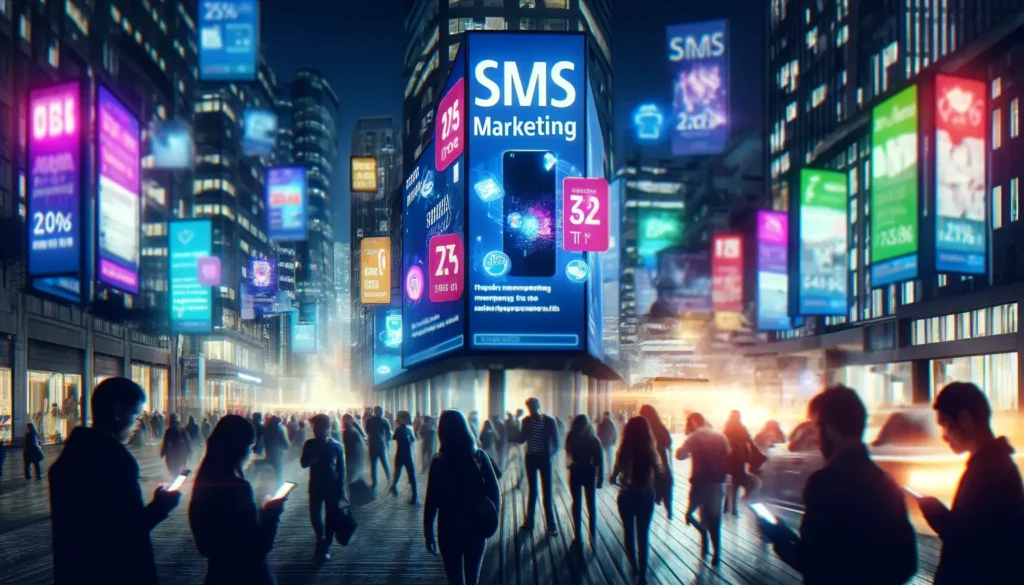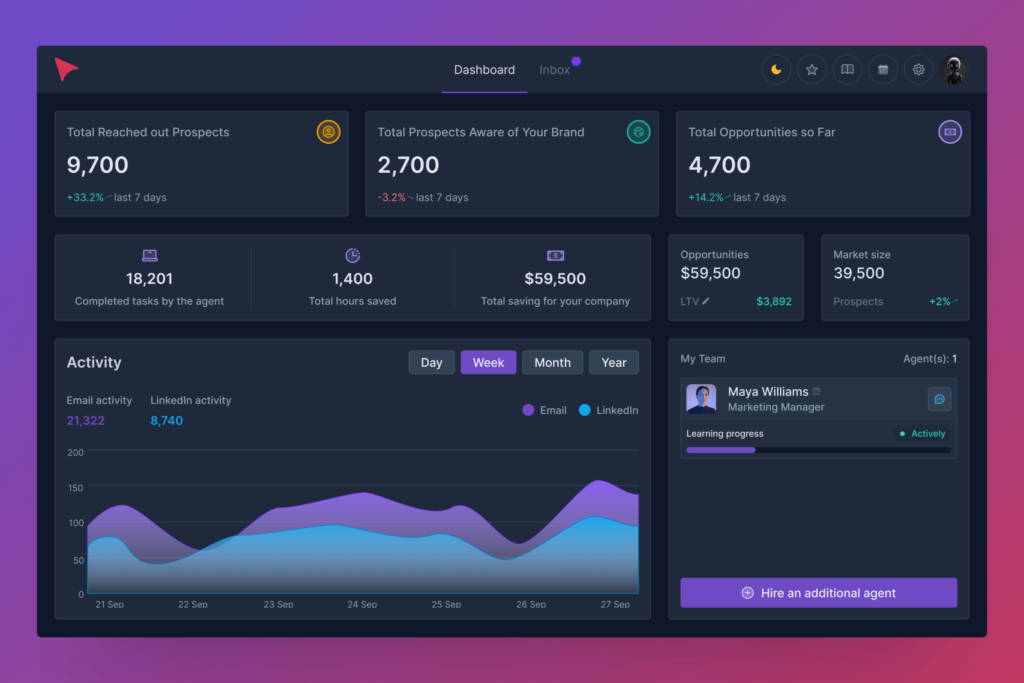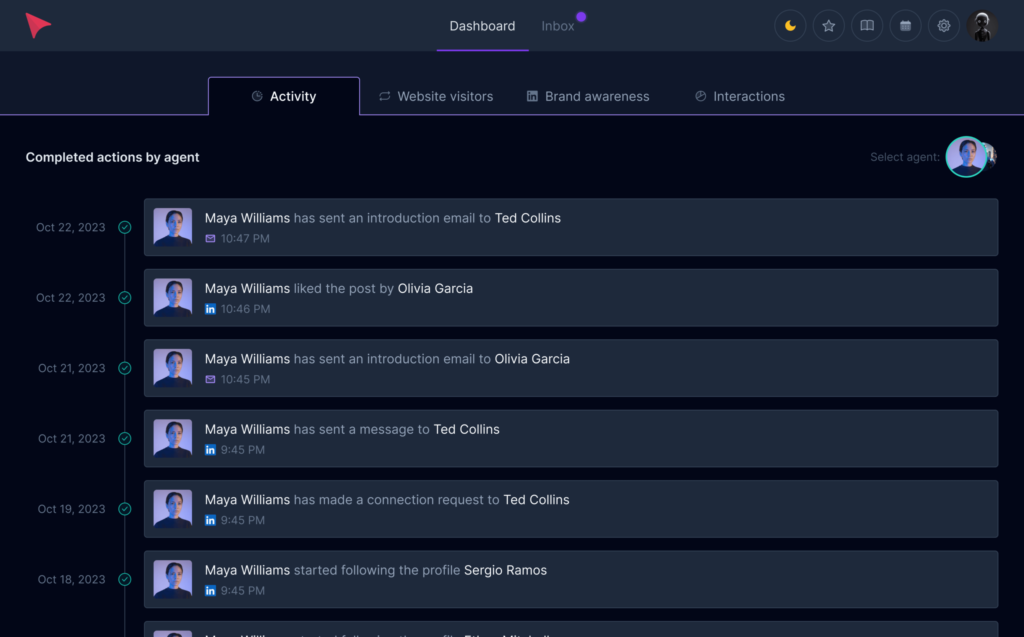The solar industry has been experiencing explosive growth in recent years, propelled by growing environmental awareness, advancements in solar technology, and favorable government policies across the globe. Solar power has become incredibly popular in many parts of the world, making the market highly competitive and underscoring businesses’ need to be able to find interested customers and keep them.
Hence, effective lead generation strategies are no longer merely practical or helpful and have become essential components of solar companies’ business models aiming to profit from the booming industry.
AI-driven lead generation strategies dramatically change how solar businesses can find and engage with potential customers, offering a level of micro-targeting, efficiency, and scale-worthiness unreachable for manual and semi-automated approaches. Therefore, the solar industry, as well as many others, is actively integrating technology and digital transformation trends to stay relevant and competitive.
Understanding Solar Lead Generation
For solar businesses, lead generation may be defined as the process of finding and generating potential customers for their solar energy products and services. More crucially, lead generation is the first step in the sales funnel that allows capturing interest in solar solutions and nurturing it to a successful sale or investment .
Lead generation implements many strategies and channels, such as online content, advertising, community outreach, and more, that are developed to bring to businesses and engage in meaningful conversation everyone who can be interested in becoming a solar adopter, whether a regular household or a large corporation.
The importance of lead generation in the solar industry is hard to underestimate. As the demand for renewable energy solutions grows, competitive pressures in the market do that as well. Therefore, companies have to secure both a competitive advantage and open up a niche for themselves and excellently communicate the benefits of consuming solar energy to a diverse audience.
In overall, lead generation is vital for:
- Awareness: informing the market on the advantages of solar power, such as saving money, a green impact, and energy freedom.
- New Sectors: accessing new market segments and territories to extend the product market and solar services provided.
- Acquisition: consistently acquiring interested leads to sustain sales volume and increases a customer base is efficient.
- Information: obtaining information about prospects is critical to customizing selling strategies and products.
- Care: producing motivation to utilize solar power for humanity’s maximum good through environmental conservation.
Buying vs. Generating Solar Leads
One of the most challenging tasks in the solar industry is the search for quality leads, and companies often face a dilemma – should they buy the leads or generate them? Both options bring their own set of benefits and drawbacks, depending on the cost difference and other variables, such as the time and resources companies can dedicate and their overarching strategy to secure leads.
Buying Solar Leads
The first option – purchasing leads – is defined as a list of potential clients bought directly or from the third party, who collects them through various marketing campaigns.
Pros:
- Immediate Access. Buying leads ensures that the firm has immediate access to prospects, which is essential in organizing the outreach.
- Effìciency. It saves the time and resources associated with starting in-house leads generation requisitions .
- Scalability. The marketing and promotions can be scaled relatively quickly in correspondence to the budget and capacity to accommodate new leads.
Cons:
- Cost. Buying high quality leads could be expensive, and that is also not a guarantee that they are going to get converted into sales.
- Ethical issues. Sometimes the ways of getting these leads, that lead providers are using do not match the ones your software company has.
- List’s relevancy and quality. It is more than often that a company will buy a list and get that it old or some of the contacts in it are irrelevant that again decreases the quality of investment.
- Competition. It goes rare that you were the only one that a company was sending its offers to, and that for sure decreases on how likely the deal was going to get closed.
Generating Solar Leads
Generating leads in-house involves using your own resources and strategies to attract potential customers directly.
Pros:
- Control. The most obvious advantage is the power of the lead generation process from targeting to message crafting.
- More relevant. The leads are of higher quality and relevance since they are based on particular campaigns and dynamics of targeting.
- Brand engagement. I believe direct engagement helps build a connection between a brand and a potential customer.
- Data insights. Significant data and insights into the effectiveness of marketing campaigns and preferences of the customers may lead to optimization.
Cons:
- Time consuming. Generating high-quality leads using different lead generation tools and techniques can be time-consuming. Companies have to design, develop and iterate plans to make each campaign successful.
- Upfront Investment. Successful lead generation requires an upfront financial investment. The costs associated with SEO, content creation, and social media campaigns can be high .
- Skill requirement. To develop effective lead generation strategies required experts and skilled people in the field to do it for you or to train your in-house marketing team.
- Difficulties in Targeting. The ability to be on point in identifying the target market for a lead generation strategy and putting it across are essential. If a company can’t do so on its analysis, sloppy work from loyal clients would not be encouraged.
The AI Advantage in Solar Lead Generation

Artificial Intelligence is also an integration that is changing how the solar industry’s lead generation functions. It is reshaping how businesses find, attract, and convert potential and targeted customers. AI tools aim to confront the traditional difficulties of lead generation head-on and offer a more intelligent, efficient approach designed to meet the needs of a contemporary solar company straightforwardly.
Using massive amounts of data to pinpoint prospects most likely to convert ensures that marketing efforts aren’t squandered on uninterested parties. This not only improves lead quality but also increases return on investment by concentrating resources where they will do the most good.
Automation and personalization driven by AI eliminating the requirement for a labor-intensive, manual effort and providing scalable, meaningful engagement with individual prospects.
AI’s predictive qualities ensure that marketing budgets are spent more wisely, targeting leads that are more likely to convert rather than those that aren’t and improving campaigns in real time through data-driven decision-making. This approach drastically decreases the financial dangers associated with both generating and purchasing leads.
As your firm expands or market dynamics change, machine learning technologies integrated in AI software systems can be dynamically adjusted. There is always a loop of learning and progress to ensure the effectiveness of strategy in AI.
AI-Powered 11 Solar Lead Generation Strategies
1. Content Creation and Distribution
Creating content involves developing valuable, informative, and interesting information for any potential solar consumer. Such content can be articles and posts on blogs, photos and videos, infographics, and posts on social networks: its purpose is to tell the audience about the advantages and problems of solar generation, answer often asked questions, and present your solutions.
Implementation with AI
AI tools can become indispensable for this strategy – you can use them to analyze data, find topics that are trending, create content optimized for search engines and personalized to different sections of your audience.
The following steps may be considered for implementation:
- Topic identification: for instance, you can monitor current trending subjects and discussions on Twitter to identify topics most popular with your target audience.
- Content creation: if you are not sure how the content should look like or are struggling to generate some ideas for what to write – use an AI content creation platform for generating drafts text or even creating more detailed text, such as articles or video scripts. Ensure that generated text in readable, and a proper amount of keywords are assimilated into in informed and meaningful way; Moreover, the resulting content should be well-structured and align with SEO best practices.
- Content personalization: Also, use AI to segment the audience by behavior, interests, and engagement with previous publications or emails. This will help to personalize the coming content – you will be able to address the problem areas that were pinpointed during analyzing. Thus, you will create a more engaging piece of content applicable to the target audience.
- Publishing: Next, use AI algorithms to analyze the best time of day, day of week, or most optimal channel for distributing content. Social media, email newsletters, and a website itself might be optimized for the maximum capacity of the AI.
- Performance analysis: Use an AI-analytics tool to gain as much insight from each content as possible. For instance, you might analyze some engagement, conversions, or rankings for SEO and continue working on your strategy for improvement.
2. Craft Messaging for Both Residential and Commercial Solar Leads
To develop suitable communication strategies, a company needs to craft messaging that aligns with the unique needs, challenges, and drivers of residential and commercial solar prospects.
- Residential. As a high-ticket item, residential customers have a high awareness of the product and generally see the benefits: savings on energy, cleaner energy, and resilience from the grid.
- Commercial. High ticket item. May not have enough corporate awareness, which may be influenced by field marketing. Longer-term cost savings, environmental, and social responsibility certifications.
Implementation
Identify Audience Needs. First, you should analyze the audience’s unique characteristics, preferences, and pain points for both audiences – residential and commercial. You can get such information through surveys, market research, or customer interviews .
Segmentation. Consider clustering the audience depending on their nature. Specifically, the residential and commercial leads and another possible segmentation factor – expandability, situation in city/region, or existing knowledge about solar energy.
Message Development. Residential leads should be approached according to how solar energy can benefit them personally, such as reducing utility bills expense, doubling the property value, or contributing to forest conservation. Commercial leads should be offered how solar energy can significantly reduce their expenses, such as increase return of investment, utilize tax rebates, and boast company culture by including green energy.
Tailor Communication Channels. Residential leads may be more interested in social and community channels and email newsletters. Commercial leads should be attracted using social networking and direct messages.
Customizes Content. Produce content that talks to each target group separately. Residential target group content may include playbooks, infographics, and personal reviews. Commercial target group might be most appealed with whitepapers, ROI calculators, and usecases .
Feedback Loop. Create a mean of collecting feedback. Feedback may be presented in conversion rates, customer testimonials, or direct emails. Improve the process depending on the feedback.
3. Email Marketing Automation
Email marketing automation is simply the process of sending emails to potential clients and other clients at the right time and delivering the material and other offers to them directly to their email inboxes
Implementation with AI
- Segment Your Audience. Use AI to divide your email list into groups of people who are most likely to be interested based on demographics, interactions, and interests, then tailor campaigns to meet their unique needs. Whether homeowner or business, you end up directly talking to someone interested in solar solutions.
- Personalize Content. AI in emails. AI systems use machine learning algorithms to analyze behavior and tailor the email to an exact mind. With algorithms, you make the subject line, body, or offer in the email directly.
- Optimize Send Times. AI algorithms find the perfect time to send an email to a subscriber to increase the open rate and the response rate to each email segment.
Automate Campaigns. Additionally, send automated emails triggered by consumer behavior, making them very effective but also timely. - A/B Testing. Elements of emails, subject lines, colors, graphics, and text can be quickly and easily A/B tested with an AI in emails.
- Analyze Performance. Finally, AI gathers data and metrics in real-time and compiles comprehensive reports to analyze subsequently. This helps our marketing team understand what action or offer had the most impact.
4. Run Paid Ads to Interested Prospects
This strategy involves using online advertising platforms to run targeted ads towards users whose behavior indicates interest in solar energy solutions. Companies can collect demographic and other data points about users most likely to be receptive to solar power and place ads where prospects are most likely to see and click them.
Implementation
- Research Your Audience. Using Google Analytics and social media insights, identify your target audience’s characteristics and behaviors as fast as possible. Solar energy should be a priority.
- Select Ad Platforms. Choose platforms like Google Ads and social media like Facebook, Instagram and LinkedIn, for how precisely they let you target your audience.
- Set Up Targeting. Target people identified in the research above – individuals who have shown interest in solar solutions depending on their online activity.
- Create Engaging Ads. Ensure that ads created are fully adjusted to the online behavior and interests with key benefits, offers, and unique selling points emphasized in ads.
- Optimize Landing Pages. Ensure ads’ landing pages are properly optimized as well, including fast loading and mobile optimization.
- Budget and Bid Smartly. Allocate the budget and adjust the bids to maximize your ROI based on the first results and goals.
- Monitor and Optimize. Watch for CTR and conversion rates and reoptimize your strategy.
5. Local Marketing Techniques
Additionally, local marketing techniques concentrate on identifying potential leads who live close by. Geolocation data powered by AI technology makes it easier to find target and potential leads that live close enough to have a high probability of being interested in solar solutions. For solar companies that have to rely on local markets, this technique is highly effective because personal messaging focused on the community has a significant impact.
Implementation
- Analyze Geolocation Data. Use AI to identify the best areas with solar potential by analyzing how much sunlight they receive, how much residents pay for energy, and how popular solar has been in the area over time.
- Run Targeted Ads. Set up location based advertisements on Google ads and social media to let people know how much money they can save on solar and address their unique concerns on solar energy with a custom message.
- Optimize for Local SEO. Make sure your HVAC business shows up when someone searches for local thrusters. .
- Engage with your community. Attend local events and work with local projects your local targets have an interest in, using AI to help you find opportunities.
- Create custom website content. HVAC business owners have had a lot of success both online and offline by creating these contents that focus on your local success stories and perks of your local offers in terms of benefits.
- Focus on the socials. Make sure your brand sounds like it’s from your neighborhood. Pay attention to their neighborhood’s issues and help them solve more small problems.
- Track performance in your area. Use AI analytics to see how your local user generation is performing.
6. Launch SMS Marketing Campaigns

SMS marketing campaigns consist of sending personalized SMS messages straight to your potential leads’ mobiles. Since SMSs are often opened and skimmed on, that’s how you can attract interest by getting right into the point. Perfect for simple time-bounded offers and reminders.
Implementation
- Segment Effectively. Use your available customer data to accurately segment your target audience and make every SMS hyper-relevant and well-targeted based on individual interests and behaviors.
- Personalize Messages. Compose to-the-point high-impact SMSs addressing each segment of the audience and use dynamic elements such as names and offers tailored to their behaviors and engagement with the brand to seem less canned and more personal.
- Stay Compliant. Ensure compliance with the law by collecting consent and offering a clear and easy opt-out in every SMS.
- Optimize Timing. Determine the optimal time to send messages based on your target audience’s communication patterns and demography to get the most out of your messages.
- Clear CTAs. Include an obvious call-to-action in each message that tells the recipient exactly what they can do to make the conversion as easy as possible.
- Cross-Channel Integration. Improve your SMS campaign by extending its influence and creating a uniform experience across channels in your broader marketing approach.
- Monitor and Adjust. Monitor your SMS key performance indicators 24 to refine your strategy, messaging, and targeting.
7. Referral Program Optimization
This consists of utilizing AI to examine consumers’ data and determine the best people to recommend new customers, as well as using personalized incentives that enable these putative referrers. Because these programs are specifically tailored, the quality of these references gets high, and they convert by utilizing trust and former patrons’ networks.
Implementation
- Spot Referrers with AI. With AI, quickly find and target high-potential referrers based on their level of engagement and clout within your customer pool.
- Tailor Incentives. Use AI to offer rewards tailored to referrers based on your finding – from discounts to unique benefits, keep them motivated.
- Automate Outreach. Begin an automated, referral-specific marketing campaign that introduces them to the program and informs them about their benefits.
- Monitor and Adjust. Do not abandon the rewards to chance – use AI statistics and tracking tools to monitor referrers’ success and rewards custom elements – readjust as necessary.
- Iterate for Improvement. Use AI to enhance your identification of the right referrers and proper rewards for them. Improve.
8. Social Media and Community Engagement
An example of using AI is the analysis and maintaining of potential leads on social networks. AI technology allows for more detailed analysis of the behavior and preferences inclinations of the target audience. The main tools of AI on social networks are the possibility of a more profound analysis of social networks, which can identify the most influential leaders and communities .
Implementation
- Analyze Audience. Use AI to quickly analyze social media data and identify audience trends, engagement hotspots, and content preferences to help you adjust your tactics to fit people’s norms better.
- Personalize Content. AI helps you create personalized messages or visuals for your social media content to match your audience’s personal interests.
- Find Influences. AI helps you find key influencers and community leaders important to your target market and extend your reach and credibility.
- Optimize Engagement. Use AI to interact and instantly respond to queries ensuring timely and appropriate communication with your leads.
- Monitor Performance. Track your performance metrics in real-time, focusing on the engagement and conversion rates with AI.
- Refine Strategy. Use AI insights to polish your current approach and make your leads and customers’ engagement activities more effective.
9. Engage at Local Trade Shows and Community Events
Another excellent strategic plan of engaging the community directly is attending local trade shows and events. This not only offers face-to-face and in-person marketing but also opportunity to meaningful conversation, get immediate feedback, meet prospects, a stronger connection with the audience, and hence more brand visibility and lead generation.
Implementation
- Event Selection. Handpick events that attract your target audience and allow your installed solar solutions to blend seamlessly. Opt for trade shows, community events, and sustainability events within the local vicinity.
- Engaging Material. Design an engaging and informative material that resonates with the audience at the event. These could be brochures, demo videos, and interactive solar panels demonstrations to inform the audience more about the benefits of solar energy.
- Interactive Booth Design. Construct compelling structures where the audience can easily interact with your material. Make sure they have an opportunity to ask questions and engaging images to catch their attention.
- Staff Training. Ensure staff is well versant with the material and can answer any emerging questions from the audience. Additionally, they should collect lead information and continue the conversation post-event.
- Promotional Offers. Offer discounts or offers to early adopters who may develop immediate interest during the exhibition.
- Follow-Up Strategy. Collect as many leads as possible and build a measurable follow-up plan to identify purchase interests.
10. SEO Optimization for Solar-Related Searches
Use AI tools to optimize your website to ensure that your website ranks higher on the search engine for solar-related searches. SEO optimization involves improving your website content, keywords, and other technical SEO aspects to rank better on the search engine for terms your target audience is looking for, generating more organic traffic to your website.
Implementation
- Keyword research. Use AI-powered tools to conduct extensive keyword research, revealing the terms and phrases your audience uses to search for solar products and solutions. AI can gather information about your audience’s queries and provide recommendations on the keywords to include in your content in a natural way. This will help you create content that aligns with your audience’s questions and needs.
- Content optimization. AI can improve your existing content and suggest new ideas for high-quality articles, making sure you include the keywords naturally.
- Technical SEO. Your website should not have broken links, slow load times, or any other issues that can hurt your rating. Use AI to audit your website and get a list of issues to fix.
- Backlink analysis. Use AI to analyze your backlink profile and determine the websites that can link to your pages.
- User experience. Integrate AI performance to better understand your website visitors and their behavior on your site. Route patterns that would need to be modified and issues that need to be addressed for better engagement.
- Performance analytics. Set up analytics that use AI capabilities to follow your website performance after SEO enhancements. This list can be vast and ever-changing.
11. Implement a Solar-Specific CRM System
Another vital tool is Customer Relationship Management System used to systematically manage, track, and nurture leads, and customer interactions throughout the sales process. In this case, a solar CRM is a technology that not only organizes customer retention but also automates disseminational communication, monitors sales quotas, and recommends up sales or follow-ups.
Implementation
- Choose the Perfect CRM. Find a CRM that suits your solar business needs, thinking about growth, integrating with other software, and solar-specific features.
- Customized. Make the CRM work for the solar sales cycle by turning it into a project tracking system and using it to handle schedules and custom sales materials.
- Segment Efficiently. Create segments to store notes about every customer and lead for closer and more efficient communication and marketing.
- Automate for Engagement. Utilize automatic communications to ensure that every lead gets a response and stays in touch throughout the entire sales process.
- Monitor Interactions. Use the CRM to manage every interaction, from cold call to final conversion, learning the most you can about your customers and what drives the sale.
- Refine continuously. Utilize the CRM’s data to look at trends and areas for improvement when it comes to sales and marketing. Never stop evolving your strategy.
The Problems with Traditional Lead Generation
As important and most used as they used to be, traditional methods of lead generation have a number of fundamental challenges that are associated with them and may impede efficiency and effectiveness: a high level of costs; the risk of incorrect targeting; ethical concerns; and unresponsive lists.
First, traditional campaigns and purchasing of leads can be extremely costly but not cost-effective ways for a business.
Second, there is a significant risk of efforts being wasted on leads that are not interested in solar solutions or not those with the financial ability to purchase them, which results in poor conversion rates.
Third, the use of traditional methods, especially those related to unsolicited outreach, can create ethical issues from the perspective of the invasion of privacy and provoke customer distrust;
Fourth, using unsolicited lists of leads purchased from third parties or having been created long ago may prove to be unproductive and a waste of resources.
Optimizing Solar Lead Generation with AnyBiz.io

The solar industry is still in its infancy and lead generation is a fundamentally impactful activity for any company’s future trajectory. In this sense, AnyBiz emerges as a pioneering AI-powered platform literally destined to change the entire marketing campaign method for solar businesses.
AnyBiz has been envisioned as a comprehensive tool that utilizes the potential of artificial intelligence technology to enhance businesses’ solar lead generation. The numerous advanced features of the tool guarantee that solar businesses receive a smarter and more efficient means of reaching out to prospective clients while developing the relationships leading to successful conversion.
How AnyBiz Addresses Traditional Lead Generation Challenges

AnyBiz stands at the forefront of transforming B2B lead generation for the solar industry, armed with AI-driven sales agents that redefine the efficiency and effectiveness of engaging potential customers. Through sophisticated artificial intelligence, AnyBiz tailors its approach to each prospect, delivering personalized messages across various channels based on their recent activities and interests. This not only elevates personalization to unprecedented levels but also streamlines the sales process far beyond traditional capabilities.
Offering a robust suite for both outbound and inbound sales activities, along with managing brand awareness, AnyBiz operates non-stop. It’s designed to adapt and refine its strategies, analyzing a myriad of data points to enhance performance continuously. With tools like pre-warmed encrypted email accounts and seamless CRM integration, plus a vast database of over 80 million prospects, AnyBiz equips solar businesses with everything needed for exponential growth without the manual labor typically associated with sales and lead generation.
AnyBiz is engineered to be a catalyst for B2B companies aiming to efficiently scale their sales endeavors. It merges inbound and outbound marketing strategies to maximize lead generation potential, even incorporating features like IP recognition for targeted outreach and automated meeting scheduling to ensure your efforts are focused solely on closing deals. With capabilities for multi-language outreach and multi-channel engagement, AnyBiz is positioned not just to broaden your reach but to deepen connections with prospects globally.
This platform is a game-changer for the solar sector, offering a smarter, faster, and more reliable method for connecting with potential customers and securing deals. With AnyBiz, solar companies can accelerate their business growth, positioning themselves as industry leaders through enhanced lead generation and sales strategies.
Conclusion
The journey through AI-powered solar lead generation ultimately illustrates a stepping stone for solar businesses with ambitions of a successful navigating in the increasingly complex market. Once merged with the integration of platforms such as AnyBiz and Artificial Intelligence, these strategies could truly become a seminal of how solar companies are generating leads in general—less time-consuming, more focused, and above all, more efficient.
Summing up, solar lead generation will truly adopt affordable and sustainable AI technologies in the near future. The companies that choose to implement these solutions will be far ahead of their closest competitors. The guide outlined above is the foundational document for solar companies in such an era: vector that navigates into the convincing, focused, and humanless AI lead generation future.
Want to know more? Read also:
- AI-Driven 10 B2B SaaS Lead Generation Strategies [+Examples]
- Proven 11 Outbound Lead Generation Strategies for Pros [+Tips]
- Best 15 Outbound Lead Generation & Marketing Agencies in 2024
FAQ
What are AI-powered solar lead generation strategies?
AI-powered solar lead generation strategies are implemented with the help of artificial intelligence to optimize the process of reaching and converting consumers who may become interested in solar energy solutions. AI tools are used to improve the target search, provide smart content, and lead customer relations management
What’s unique about AnyBiz’s approach to lead generation?
Special effect of technology works thanks to AI-driven sales agents who conduct personal and multi-channel activities for all types of sales – outbound and inbound. They constantly learn and adapt to change, which makes the product better every second.
Can small solar businesses benefit from AI-powered strategies?
De-escalatingly, AI-powered strategies are scalable and can be adapted to accommodate the small solar business’s budget and resource constraints. The small business can effectively reach potential customers with little manual effort and high ROI.
How does AI targeting work for solar lead generation?
AI targeting utilizes massive data involving user behavior, preferences, and demographics to classify potential people that might be interested in solar solutions. This fosters a more precise and highly focused marketing process.
How does AI manage multi-channel engagement?
Normally, AI employs powerful algorithms to organize and enhance engagement over many channels, including email, social media, website, etc. Furthermore, with AI and algorithms in place, your brand will be able to produce coherent messages tailored to that specific channel and user preference.
What metrics can AI help track in solar lead generation?
With AI, marketers can track many different metrics, such as engagement and conversion rates, lead quality scores and campaign ROI. All of these are essential to perfect and continually enhance your strategy






